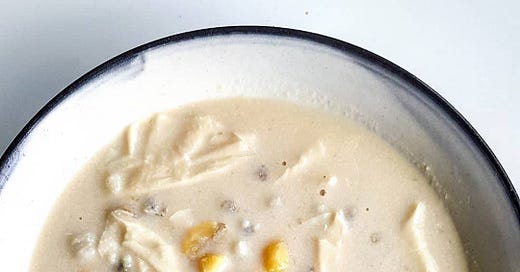To combat Singapore’s merciless heat, my mother always stocked the fridge with herbal tea and ‘cooling’ soups were always a part of our dinner table. She also used to make this dessert of ginkgo, barley and dried tofu skins called ‘fu juk tong sui‘. A key ingredient in traditional Chinese medicine, ginkgo nuts improve blood circulation, improve memory retention and prevent free radical damage. Pearl barley supports the immune system while fighting against diabetes, heart disease and cancer. Dried tofu skin (‘fu juk‘) is high in protein and calcium while being low in fat. Even the rock sugar, used in the making in this dessert, eases a sore throat!
This is a simple dessert, but there are a few points to note.
Add pandan: The leaves of the pandan plant is what lends local flair to this very traditional, Cantonese dessert. Considered the vanilla of the East, pandan has a subtle, floral flavour that pairs beautifully with the gentle flavours of this dessert.
Add the dried beancurd skin in two additions: Most recipes for this dessert on the internet add dried beancurd skin towards the end of cooking. This produces a result that is akin to beancurd skin, barley and ginkgo suspended in a sugar syrup. I prefer adding dried beancurd skin in two additions. I simmer the bulk of the yuba with pandan and barley until it fully melts into the sugared water. Eventually, the pieces of beancurd are so miniscule that it gives the ‘soup’ a milky appearance and a creamy mouthfeel. The remaining skins are only briefly warmed to retain its texture, resulting in two mouthfeels of the same product in the dessert.
Soak the beancurd skins in water and baking soda: Cooks often add a pinch of baking soda to soaking chickpeas to hasten their breakdown when making hummus. In the same way, the alkalinity of the soaking liquid hastens to breakdown of dried beancurd skin.
Remove the bitter shoot of ginkgo nuts and boil: Whether you used shelled, packaged ginkgo nuts or fresh ginkgo nuts, ginkgo can have a strong, unpalatably bitter flavour. This is due to the shoot growing in the centre of the nut. To remove it, some cooks use a toothpick. Others snip the nut in half and, with the tip of a knife, remove the shoot. A quick boil in water helps to further eradicate bitterness.
‘Egg flower’: When my mother cooks this dish, she likes beating an egg into the hot dessert to form what she calls dan hua (‘egg flower’). As the egg cooks, it forms thin, delicate ribbons of egg which complement the silky texture of the yuba. Some people enjoy this addition, but I can’t get over the idea of eating egg in my dessert.
Ginkgo, barley & dried yuba dessert
Serves 4
100g dried yuba, torn finely
100g pearl barley
30g dried yuba, torn coarsely
4 pandan leaves
80g rock sugar
100g vacuum-packed or canned ginkgo
1 egg or 1 egg white, beaten (optional)
Soak the finely torn dried yuba with 1 teaspoon baking soda and 2L water for 30 minutes. Meanwhile, soak the pearl barley and coarsely torn dried yuba in water separately.
Drain the finely torn yuba and rinse well before combining in a pot with 2L water, the drained barley, pandan and rock sugar. Bring to a boil, then cook over medium low heat for 1 hour, stirring occasionally. The yuba should have fully disintegrated and the barley should be tender.
Halve the ginkgo lengthwise and remove the shoot in the middle. Place in a pot with water and bring to a boil. Cook for 5 minutes.
Remove the pandan leaves from the pot. Drain the ginkgo and the coarsely torn yuba and add to the pot. Heat just long enough for the yuba to soften but not disintegrate, just a few minutes. If you like egg in this dessert, dribble in the beaten egg while stirring on low heat till ribbons of egg form. If not, serve as is, hot, cold or room temperature.




